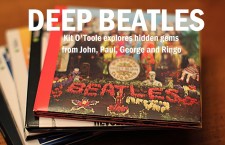Next in the Abbey Road medley is one of the Beatles’ most beautiful yet mysterious tracks, “Sun King.” In later years, John Lennon dismissed “Sun King” as “a piece of garbage I had around,” but its lovely harmonies and mystical lyrics transform it into an entrancing listening experience.
Supposedly the title came to Lennon in a dream, but some Beatles historians speculate that the phrase may have derived from the popular 1966 book The Sun King, a history of King Louis XIV. The chord progression originates from Lennon’s composing tear during the group’s 1968 India sojourn. Previously, Lennon brought in the piece during the 1969 Get Back sessions, and its chord progression closely resembles another Lennon composition from the period: “Don’t Let Me Down.” Listen to the two songs back-to-back to note the similarities.
However, another musical influence entered the studio — Fleetwood Mac. In 1968, the Peter Green-iteration of the band released “Albatross,” a dreamy instrumental driven by Green’s reverb-filled guitar solo and chords emulating the tide rolling in. In a 1987 interview, George Harrison revealed that the single inspired the Beatles to rework “Sun King.” “At the time, ‘Albatross’ was out, with all the reverb on guitar. So we said, ‘Let’s be Fleetwood Mac doing “Albatross,” just to get going,’ Harrison said. “It never really sounded like Fleetwood Mac … but that was the point of origin.”
While “Sun King” may not exactly duplicate the track, the mellow quality of the song, created with melodic guitars and sound effects like chimes and use of cymbals, faintly echo “Albatross.”
Soon after the Beatles abandoned the Get Back sessions, they returned to Abbey Road to record their final album. Paul McCartney revived “Sun King” for the medley; by this time, Lennon had changed the lyrics and titled the song “Here Comes the Sun King,” perhaps a wink at Harrison’s composition “Here Comes the Sun.” Obviously, the moniker changed to avoid confusion between the two tracks. Next came the addition of the mysterious ending lines — what do they mean? Lennon and McCartney later admitted the words were pure gibberish, but in four different languages. While individual words were real, strung together they made little sense.
A Lennon interview aired during the Anthology documentary further explains:
When we came to sing it, to make them different we started joking, saying “cuando para mucho.” We just made it up. Paul knew a few Spanish words from school, so we just strung any Spanish words that sounded vaguely like something. And of course we got “chicka ferdi” — that’s a Liverpool expression; it doesn’t mean anything, just like “ha ha ha.” One we missed: we could have had “para noia,” but we forgot all about it. We used to call ourselves Los Para Noias.
Further evidence of Lennon’s assertions can be found during the 1968 White Album sessions, most notably in the outtake “Los Paranoias.” The Latin feel present in “Sun King” can be heard in this studio jam.
Recording began on July 24, 1969, with “Sun King” and “Mean Mr. Mustard” fused as one track. They taped 35 takes, with Lennon on rhythm guitar and guide vocal; McCartney on bass; Harrison on lead guitar; and Ringo Starr on drums. They returned to Abbey Road the next day to overdub vocals and piano, and added an organ part played by George Martin.
Finally, the group finished “Sun King” on Jul 29 by overdubbing more vocals, piano, organ, and percussion.
According to engineer Geoff Emerick, Starr would drape tea towels over his drums to achieve a softer sound, hitting them with timpani mallets rather than drumsticks.
Indeed, Starr’s beautifully understated work is key to establishing the song’s intimate atmosphere. His drums gain power abruptly before segueing into “Mean Mr. Mustard.” Similar to “Because,” Harrison, Lennon, and McCartney’s seamless, triple-tracked harmonies still amaze.
“Sun King” remains an intriguing part of the medley. Its haunting quality — the chirping sound effects suggesting walking outside in the middle of the night — provides a soothing diversion from the intensity of “You Never Give Me Your Money” as well as the gradual build to the medley’s climax. Lennon may have called it “a piece of garbage,” but “Sun King” serves as a crucial part of Abbey Road.
For more evidence of its stunning quality, listen to the Cirque du Soleil Love version, which features the track backwards.
- How John Lennon Came Roaring Back on the Beatles’ White Album - November 22, 2023
- Five ‘With the Beatles’ Deep Cuts That Illustrate Their Lasting Debt to R&B - November 20, 2023
- Five Must-Hear Deep Cuts from the Beatles’ ‘Past Masters’ - March 7, 2023


